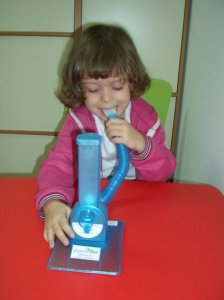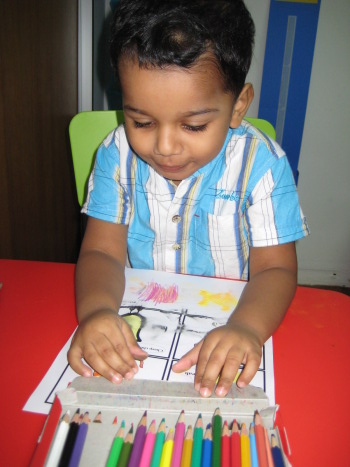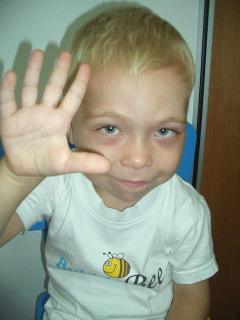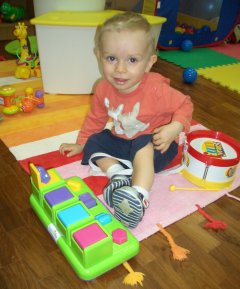Speech Therapy
We are a company in Singapore providing speech therapy as well as language and communication therapy. Parents are sometimes worried seeing their child not talking, being passive, not playing with peers or playing inappropriately. We may help to address such concerns by assessing areas of need and working on improving communication. We provide support for various developmental delays, including autism spectrum disorder, sensory processing difficulties, dyspraxia, speech delays and social difficulties.
BubbleBee offers speech and language therapy for children and provides comprehensive
BubbleBee offers speech and language therapy for children and provides comprehensive
services that include:


- detailed assessment comprising of informal clinical observations, with the use of special therapeutic instruments, standardized tests (if necessary) and detailed parents/caregivers interview in order to analyze and diagnose the nature and extent of
 speech, language or communication disorder. Such assessment usually takes from one to three visits and may be followed by a detailed report outlining the diagnosis and recommendations for the therapy,
speech, language or communication disorder. Such assessment usually takes from one to three visits and may be followed by a detailed report outlining the diagnosis and recommendations for the therapy, - development of individualized treatment plan, tailored to each patient's needs, with precise goals defined,
- therapy care including:
- individual sessions (1 hour per session),
- group therapy sessions,
- review appointments for clients who don't require regular therapy,
- feedback and counseling sessions for caregivers, educators and family members (based on a particular client's needs).
ORAL-MOTOR THERAPY

This therapy approach addresses oral-motor based speech difficulties, i.e. when the child is experiencing difficulties with muscle placement and strength, alignment of oral structures and control of precision movements required for speech and feeding. Oral-motor exercises are performed to help strengthen and tone the muscles of the tongue, lips, jaw and cheeks. The exercises are carried out with the use of therapy tools, like specially designed horns, straws, tongue depressors, biting blocks etc. Oral-motor therapy can also be employed during snack-time using food. Children have a lot of fun during these exercises and in the same time may learn skills essential for appropriate speech production, as well as for eating and drinking.
PROMPT
Prompt's for Restructuring Oral Muscular Targets is a therapy technique that embodies neuromotor principles, kinesthetic and proprioceptive, auditory and visual information to provide feedback to the speech system. In other words - the therapist gives input to the structures by using touch, appropriate pressure, specific placements and auditory-visual feedback to help the client organize and control the movements for speech. The Speech Therapist provides sensory-motor cues to signal placement, movements manner, voicing and duration, as well as tension of phonemes, syllables, words, and eventually phrases and sentences.
HANEN
It Takes Two To Talk (ITTT) is a family-focused early intervention method which teaches parents how to help children with language delays. As it is the parents who best know their child and spend the most time with their child, their involvement and support plays crucial role in the child's speech and communication development. A Hanen certified Speech Therapist leads group of parents through the programme, which is a combination of consultations, group discussions, individual  feedback sessions and videotaping parents while they interact with their child. During the ITTT programme parents learn how to support their child's communication development and encourage language learning.
feedback sessions and videotaping parents while they interact with their child. During the ITTT programme parents learn how to support their child's communication development and encourage language learning.
More Than Words (after Hanen website) "..is a family-focused program that gives parents of children with Autism Spectrum Disorder (ASD) and related social communication difficulties, practical tools to help their children communicate.
More Than Words derives its theoretical basis from the same social interactionist perspective as It Takes Two to Talk, Hanen's program for parents of pre-school children with language delays. Like this program, More Than Words emphasizes the child's everyday activities as the context for learning to communicate. In addition, More Than Words incorporates current best practice guidelines, highlighting the importance of affect, predictability, structure and the use of visual supports to enhance learning in children with ASD. The Program is organized around four major goals:
 feedback sessions and videotaping parents while they interact with their child. During the ITTT programme parents learn how to support their child's communication development and encourage language learning.
feedback sessions and videotaping parents while they interact with their child. During the ITTT programme parents learn how to support their child's communication development and encourage language learning.
More Than Words (after Hanen website) "..is a family-focused program that gives parents of children with Autism Spectrum Disorder (ASD) and related social communication difficulties, practical tools to help their children communicate.
More Than Words derives its theoretical basis from the same social interactionist perspective as It Takes Two to Talk, Hanen's program for parents of pre-school children with language delays. Like this program, More Than Words emphasizes the child's everyday activities as the context for learning to communicate. In addition, More Than Words incorporates current best practice guidelines, highlighting the importance of affect, predictability, structure and the use of visual supports to enhance learning in children with ASD. The Program is organized around four major goals:
- Improved two-way interaction
- More mature and conventional ways of communicating
- Better skills in communicating for social purposes
- An improved understanding of language"
TalkAbility is a program for parents of VERBAL children with autism, PPD-NOS or Asperger's diagnosis. It is based on the same principles as other Hanen® programs, especially the one that parents or main caregivers are crucial in child's language and social skills acquisition.
TalkAbility aims at helping those children who have difficulties with appreciating another person's point of view (poor theory of mind), don't take other person's feelings into consideration, have problems making friends or experience other difficulties with social abilities.
Through a combination of group sessions and individual consultation using videotaping and feedback, TalkAbility helps parents learn how to create opportunities, as well as to take advantage of everyday conversations and activities to promote their child's communication skills, theory of mind development and peer interaction.
TalkAbility aims at helping those children who have difficulties with appreciating another person's point of view (poor theory of mind), don't take other person's feelings into consideration, have problems making friends or experience other difficulties with social abilities.
Through a combination of group sessions and individual consultation using videotaping and feedback, TalkAbility helps parents learn how to create opportunities, as well as to take advantage of everyday conversations and activities to promote their child's communication skills, theory of mind development and peer interaction.
THE LIDCOMBE PROGRAM
The Lidcombe Program is a behavioural treatment for young children who
stutter. The program focuses on parent training and consists of two
stages. The first stage is carried out through weekly visits to the
speech therapist. During these visits, the speech therapist coaches the
parent through various techniques, observes the parent, and gives the
parent feedback accordingly. The treatment involves the parent
commenting directly on the child's speech. In addition, the feedback is
mostly positive as it is mainly given when the child speaks fluently and
only ocassionally when the child stutters. The parent is also trained in
measuring fluency on a scale of 1-10. This assists the speech therapist
in tracking progress in places other than the clinic to ensure that the
child is generalising the skills that they have learnt. The child is
moved onto the second stage once the stuttering disappears or is at a
very low level. This stage is called the maintenance stage as it ensure
the maintenance of a low level of stuttering for at least one year. The
program aims to be a positive experience for the family. As all families
are different, the speech therapist will bear this in mind when planning
therapy, to ensure inclusion of all essential aspects of the Lidcombe
Program, but adjusted to suit the each family's needs.
PECS
Picture Exchange Communication System is a method which uses picture symbols to facilitate communication. The system has been first developed for children with autism and is now successfully used also with individuals who have variety of communicative, physical and cognitive difficulties. It is not a programme designed to teach speech but to communicate. Verbal communication is here encouraged indirectly and some children begin to use speech spontaneously while enrolled in the PECS programme. PECS emphasizes the importance of an individual with a communication deficit learning to approach a communicative partner. From the start communication is indicated by the child, who is encouraged to independently seek out communication partners in naturally occurring settings. People using PECS are taught to approach and give a picture of a desired item to a communicative partner in exchange for that item. While advancing through the phases of PECS, the student learns to sequence words to create sentences. PECS has many communicative purposes: it teaches interaction, it is not restricted to one setting, it facilitates rather than inhibits speech, with the end result that communication becomes meaningful and highly motivating.
SAMONAS AUDITORY TRAINING
Samonas (Spectrally Activated Music of Optimal Natural Structure) offers lots of recordings (60+) with variety of musical and natural sounds, 4 levels of intensity, individualized listening plan and personalized recordings with specific therapeutic intention. Samonas is an auditory intervention technique created for training and supporting bilateral integration, motor planning, focus, attention and discrimination. It is proved that Samonas approach helps to make progress in learning, speech and language, attention, motivation, communication, memory and information processing, focusing, task management and spatial, as well as bilateral organization.
DIR®/Floortime
The Developmental, Individual Difference, Relationship-based (DIR®/Floortime) model is a special intervention approach tailored to the needs and challenges of children with Autism Spectrum Disorder (ASD) and other developmental difficulties.
 It is an unique technique that does not focus on curriculum or on teaching isolated, required behaviors, but stimulates general child's growth in a natural way, based on six stages of typical emotional development identified by Dr. Stanley Greenspan. Floortime intervention aims to both follow the child's natural emotional interest and at the same time stimulate the child towards improved social, emotional, and intellectual abilities. This includes helping children to develop capacities to attend and remain calm and regulated (i. e., comprehend sensations such as sound, movement and touch), engage and appropriately relate to others, initiate and respond to communication, as well as learn to problem - solve and engage in social intercourses. Therapeutic goals are achieved through playful interactions with parents, caregivers, educators, therapists, peers, siblings, and others who tailor their affect based responses to the child's individual differences and developmental capacities. It enables best possible progress through meaningful, spontaneous, warm, play-based approach.
In DIR®/ Floortime™ Model parents and other family members are involved in the therapeutic intervention because of the importance of their emotional relationships with the child. You may read more on (http://www.icdl.com) - The Interdisciplinary Council on Developmental and Learning Disorders or (http://www.profectum.org) - Profectum™.
It is an unique technique that does not focus on curriculum or on teaching isolated, required behaviors, but stimulates general child's growth in a natural way, based on six stages of typical emotional development identified by Dr. Stanley Greenspan. Floortime intervention aims to both follow the child's natural emotional interest and at the same time stimulate the child towards improved social, emotional, and intellectual abilities. This includes helping children to develop capacities to attend and remain calm and regulated (i. e., comprehend sensations such as sound, movement and touch), engage and appropriately relate to others, initiate and respond to communication, as well as learn to problem - solve and engage in social intercourses. Therapeutic goals are achieved through playful interactions with parents, caregivers, educators, therapists, peers, siblings, and others who tailor their affect based responses to the child's individual differences and developmental capacities. It enables best possible progress through meaningful, spontaneous, warm, play-based approach.
In DIR®/ Floortime™ Model parents and other family members are involved in the therapeutic intervention because of the importance of their emotional relationships with the child. You may read more on (http://www.icdl.com) - The Interdisciplinary Council on Developmental and Learning Disorders or (http://www.profectum.org) - Profectum™.
 It is an unique technique that does not focus on curriculum or on teaching isolated, required behaviors, but stimulates general child's growth in a natural way, based on six stages of typical emotional development identified by Dr. Stanley Greenspan. Floortime intervention aims to both follow the child's natural emotional interest and at the same time stimulate the child towards improved social, emotional, and intellectual abilities. This includes helping children to develop capacities to attend and remain calm and regulated (i. e., comprehend sensations such as sound, movement and touch), engage and appropriately relate to others, initiate and respond to communication, as well as learn to problem - solve and engage in social intercourses. Therapeutic goals are achieved through playful interactions with parents, caregivers, educators, therapists, peers, siblings, and others who tailor their affect based responses to the child's individual differences and developmental capacities. It enables best possible progress through meaningful, spontaneous, warm, play-based approach.
In DIR®/ Floortime™ Model parents and other family members are involved in the therapeutic intervention because of the importance of their emotional relationships with the child. You may read more on (http://www.icdl.com) - The Interdisciplinary Council on Developmental and Learning Disorders or (http://www.profectum.org) - Profectum™.
It is an unique technique that does not focus on curriculum or on teaching isolated, required behaviors, but stimulates general child's growth in a natural way, based on six stages of typical emotional development identified by Dr. Stanley Greenspan. Floortime intervention aims to both follow the child's natural emotional interest and at the same time stimulate the child towards improved social, emotional, and intellectual abilities. This includes helping children to develop capacities to attend and remain calm and regulated (i. e., comprehend sensations such as sound, movement and touch), engage and appropriately relate to others, initiate and respond to communication, as well as learn to problem - solve and engage in social intercourses. Therapeutic goals are achieved through playful interactions with parents, caregivers, educators, therapists, peers, siblings, and others who tailor their affect based responses to the child's individual differences and developmental capacities. It enables best possible progress through meaningful, spontaneous, warm, play-based approach.
In DIR®/ Floortime™ Model parents and other family members are involved in the therapeutic intervention because of the importance of their emotional relationships with the child. You may read more on (http://www.icdl.com) - The Interdisciplinary Council on Developmental and Learning Disorders or (http://www.profectum.org) - Profectum™.
M.O.R.E.
Is a therapy model that focuses on the relationships between oral motor mechanisms and the sensorimotor and behavioral aspect of human function. The acronym M.O.R.E. stands for:
M otor
O ral
R espiration
E yes

The approach brings together knowledge about oral, motor, respiratory functions and understanding of sensory processing difficulties that children may experience to conclusion that many aspects of child's development are influenced by oral functions, such as suck-swallow-breathe synchrony.
M.O.R.E. method guides the therapist in integration of the mouth with sensory and postural functions to improve child's sensory processing, self-regulation, postural control, motor, language and social development through use of oral motor activities.
M.O.R.E. method guides the therapist in integration of the mouth with sensory and postural functions to improve child's sensory processing, self-regulation, postural control, motor, language and social development through use of oral motor activities.
Speech therapy also includes articulation, speech fluency (stuttering management), voice treatment, language (phonology, morphology, syntax, semantics, pragmatics) remediation, as well as social skills training and teaching of non-verbal communication skills, such as facial expressions and gestures.
Copyright BubbleBee, Speech Therapy Centre. All rights reserved. |